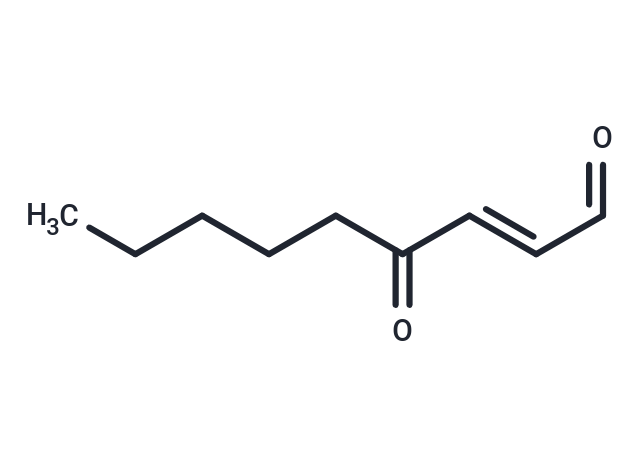 Your shopping cart is currently empty
Your shopping cart is currently empty

4-hydroxy Nonenal is a lipid peroxidation product derived from oxidized ω-6 polyunsaturated fatty acids such as arachidonic acid and linoleic acid. [1] [2] It exhibits various biological activities such as cytotoxicity, growth inhibiting activity, genotoxicity, and chemotactic activity and has been widely used as a marker of lipid peroxidation.[1][2][3] 4-oxo-2-Nonenal is a more recently identified product of lipid peroxidation.[4][5][6] It actively modifies histidine and lysine residues on proteins and causes protein cross-linking. [7][8] 4-oxo-2-Nonenal also modifies 2'-deoxyguanosine, further implicating lipid peroxidation in mutagenesis and carcinogenesis.[4]

| Pack Size | Price | USA Warehouse | Global Warehouse | Quantity |
|---|---|---|---|---|
| 500 μg | $198 | 35 days | 35 days | |
| 1 mg | $388 | 35 days | 35 days | |
| 5 mg | $1,580 | 35 days | 35 days | |
| 10 mg | $2,760 | 35 days | 35 days |
| Description | 4-hydroxy Nonenal is a lipid peroxidation product derived from oxidized ω-6 polyunsaturated fatty acids such as arachidonic acid and linoleic acid. [1] [2] It exhibits various biological activities such as cytotoxicity, growth inhibiting activity, genotoxicity, and chemotactic activity and has been widely used as a marker of lipid peroxidation.[1][2][3] 4-oxo-2-Nonenal is a more recently identified product of lipid peroxidation.[4][5][6] It actively modifies histidine and lysine residues on proteins and causes protein cross-linking. [7][8] 4-oxo-2-Nonenal also modifies 2'-deoxyguanosine, further implicating lipid peroxidation in mutagenesis and carcinogenesis.[4] |
| Synonyms | 4-oxo-2-Nonenal, 4-ONE |
| Molecular Weight | 154.209 |
| Formula | C9H14O2 |
| Cas No. | 103560-62-9 |
| Smiles | CCCCCC(=O)\C=C\C=O |
| Relative Density. | 0.933 g/cm3 (Predicted) |
| Storage | Powder: -20°C for 3 years | In solvent: -80°C for 1 year | Shipping with blue ice/Shipping at ambient temperature. | ||||||||||||||||||||||||||||||||||||||||
| Solubility Information | DMF: 50 mg/mL (324.24 mM), Sonication is recommended. DMSO: 50 mg/mL (324.24 mM), Sonication is recommended. Ethanol: 50 mg/mL (324.24 mM), Sonication is recommended. PBS (pH 7.2): 0.5 mg/mL (3.24 mM), Sonication is recommended. | ||||||||||||||||||||||||||||||||||||||||
Solution Preparation Table | |||||||||||||||||||||||||||||||||||||||||
PBS (pH 7.2)/DMF/DMSO/Ethanol
DMF/DMSO/Ethanol
| |||||||||||||||||||||||||||||||||||||||||
| Size | Quantity | Unit Price | Amount | Operation |
|---|

Copyright © 2015-2026 TargetMol Chemicals Inc. All Rights Reserved.